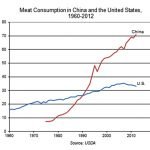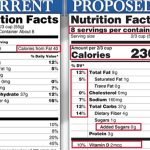Earlier this month, the Annals of Internal Medicine published a Stanford study that found that organic foods were neither substantially more nutritious nor substantially “cleaner” than non-organic products and are probably not worth the added cost.1 Crystal Smith-Spangler, Margaret L. Brandeau, Grace E. Hunter, et al. “Are Organic Foods Safer or Healthier Than Conventional Alternatives?: A Systematic Review.” Annals of Internal Medicine. 4 September 2012, Vol 157, No. 5. http://annals.org/article.aspx?articleid=1355685 As might be expected, these conclusions brought the pundits on both sides of the argument wriggling out of the woodwork. The agricultural industry trumpeted, “See, that’s what we’ve been telling you all along.” The organic industry cried, “Foul! The “small” differences that the study cited are actually important, and besides, even if they aren’t, there is bias here.” While the direct funding for the study may not have been tainted (it was funded by an undergraduate research grant), some of the researchers involved in the study are affiliates and fellows of Stanford’s Freeman Spogli Institute, which has been funded to the tune of millions of dollars by companies such as Cargill, the world’s largest agricultural business conglomerate and several agricultural chemical and biotechnology corporations such as Monsanto. “Obviously,” the pundits argued, “The researchers are merely doing the bidding of their corporate puppet masters.” Also, if that weren’t reason enough to leave the issue to others, I’ve already countered several similar anti-organic studies in previous newsletters–in fact, I’ve borrowed extensively from those previous newsletters for this report. And besides, Hiyaguha Cohen, one of our foundation staff writers, wrote a blog about this exact study several weeks ago. What more is there to say on the question: is organic food better for you?

Quite simply, the reason I’m dealing with it now is that I believe the true meaning of this study and its results have been left unexplored. Key concepts worth examining have been left on the table. Before we look into those, however, let’s take stock of where we are at this point in time. First of all, I believe that the alternative health community missed the moment and ended up arguing over table scraps as it were. As I’ve already mentioned, their argument was that the small differences cited in the study were actually important differences and that perhaps the results weren’t real anyway because of bias. But in fact, the community at large never considered the possibility that the results might indeed be real, and that the minimal differences between organic and conventional produce were not only accurate as measured, but probably to be expected. Given that, we’re left with two questions:
- Starting with the assumption that it has nothing to do with bias or inaccuracy, why are the differences in nutritional values so much lower than most people expected?
- Why were the differences in pesticide contamination also less than expected?
But before we answer these questions, let’s quickly review the specific results of the study.
Is Organic Food Better for You — the Study?
Among other things, the study concluded that:
- Fruits and vegetables labeled organic were, on average, no more nutritious than their conventional counterparts, which tend to be far less expensive.
- Specifically, the researchers stated that organic produce did indeed contain a “statistically” significant greater number of phenols, which are believed to help prevent cancer, than conventional produce. But then the researchers pointed out that the size of the difference varied widely from study to study, and the data was based on the testing of small numbers of samples. More importantly, they also pointed out that ripeness has a greater influence on nutrient content than how the fruit is grown. A lush ripe peach, for example, grown with the use of pesticides, can easily contain more vitamins than an unripe organic one.
- Organic milk contains more omega-3 fatty acids, but milk is not a primary source of omega-3 fatty acids in any case.
- Organic foods are no less likely to be contaminated by dangerous bacteria such as E. coli.
- And yes, conventional foods, including fruits and vegetables, are more likely to be contaminated with pesticide residues than organic produce–38 percent VS 7 percent–but the levels are almost always under the allowed safety limits, so the significance is minimal.
- And organic chicken and pork are less likely to be contaminated by antibiotic-resistant bacteria. But the researchers argued that any such bacteria were likely to be killed in cooking, so again no advantage to organic meats.
To fully understand what these conclusions mean, we have to back up a bit and get some context for the word “organic.”
History of Organic Farming
The idea of “organic food” has its roots in the first dawning of civilization. When you think about it, in the beginning, all farming had to be organic since there were no synthetic fertilizers or pesticides until the last century. It might not have been sustainable in some cases, as some ancient societies definitely over farmed the land and made themselves extinct, but it involved only natural components. The use of the word organic as being something more than just “natural”–as being a form of agriculture that was in harmony with nature and sustainable in addition to being natural, can probably claim its roots some 60 years ago when Oxford University agriculturalist, Lord Northbourne, in his book, Look to the Land, designated the natural alternative to chemical farming as organic farming. The term stuck and over time became the defining term for “natural” agriculture. Until the early 90’s, the use of the term was a bit loosey-goosey, but since organic farming was only practiced by those really into it, anything labeled organic tended to be truly organic. However, in the early 90’s, under the auspices of the Organic Foods Production Act of 1990,2 “Federal Organic Foods Production Act of 1990” (7 U.S. Code including amendments as of January 1, 2004). Farmland Information Center. http://www.farmlandinfo.org/documents/38361/
Federal_Organic_Food_Production_Act.pdf the USDA took control of all organic farming in the United States–and more importantly, control over the definition of the word organic. Currently, the production of organic food is governed by a raft of regulations that generally prohibit the use of synthetic pesticides, hormones, GMOs, sewage, irradiation, and additives.3 “National Organic Program.” USDA 6 June 2012. (Accessed 23 Sept 2012.) http://www.ams.usda.gov/AMSv1.0/nop
And if you thought the use of the word “organic” was loosey-goosey before the government took over, the definition of “organic” according to the government now opens the door to all kinds of interpretation and abuse that would have been considered “grave-turning” to its original practitioners. Specifically, to be sold or labeled as an organically produced agricultural product under law, the products need to match the following requirements:
- They have been produced and handled without the use of synthetic chemicals, except as otherwise provided in this chapter. [Yes, there are exceptions].
- Except as otherwise provided in the law and excluding livestock, not be produced on land to which any prohibited substances, including synthetic chemicals, have been applied during the 3 years immediately preceding the harvest of the agricultural products. [And yes, there are once again exceptions. But more importantly, regulation does not cover practices on “organic adjacent” land, and with many large agricultural corporations setting up organic plots next to their conventional acreage, which means organic produce can be contaminated by pesticide runoff from the conventional farms, we see a possible explanation for much of the organic contamination seen in the Stanford study.]
- And the organic foods must be produced and handled in compliance with an organic plan agreed to by the producer and handler of such product and the certifying agent. [And as we shall see, sometimes those agents are nowhere to be found.]
Unfortunately, this definition allows for many exceptions. Some of those exceptions come from the blatant ignoring of the law by those authorized to enforce it, and some exceptions are gently nudged in later to accommodate pressure groups and vested interests. We’ll explore this in more detail a bit later.
Organic Foods — Pros Cons
Now, this will come as a surprise to many people, but in most cases, there is likely to be little if any difference between conventionally grown and organic produce when testing for many antioxidants and even many vitamins. Since phenols and vitamin C–the focus of the Stanford study–are all comprised entirely of oxygen, hydrogen, and carbon, they can grab all of these elements from the air and water. The type of fertilizer used is irrelevant. You don’t need a degree in chemistry to understand the meaning of the following molecular formulas. They all contain nothing but carbon, hydrogen, and oxygen. For raw ingredients, we’re talking carbon dioxide and water.
- Quercetin — C15H10O7
- Beta carotene — C40H56
- Lutein — C40H56O2
- Resveratrol — C14H12O3
- Vitamin C — C6H8O6
I could go on and on, but the point is obvious: many key nutrients are assembled from nothing but carbon, hydrogen, and oxygen. For those nutrients, whether pesticides are used, or even if organic fertilizer is used, is irrelevant. The plants pull what they need to make these nutrients out of the air and water — which is equally available to both organic and conventional produce. However, the situation is different when we talk about other nutrients that contain elements not found in air and water and that are also important markers of food value. For example:
- Vitamin B1 requires sulfur — C12H17ClN4OS
- Methylcobalamin (the most active form of B12) requires nitrogen and phosphorus — C63H91CoN13O14P
But there’s more. One of the problems with commercial fertilizers is that in order to be cost effective, they provide plants with the minimal ingredients needed to make the plant grow. When it comes to conventional fertilizers, you’re pretty much talking about NPK–nitrogen, phosphorus, and potassium plus, of course, the hydrogen, oxygen, and carbon found in the air and water. Organic fertilizers, on the other hand, tend to supply nutrients across the entire spectrum (with a huge qualifier that we’ll discuss in a moment). Why does this matter?
 Consider selenium, one of the most powerful antioxidants known and a component of several powerful antioxidant enzymes. If selenium is in the soil, plants pick it up. If it’s not in the soil, they can’t pick it up. They don’t actually need it to grow. It helps with their defense against pests, but for the most part, plants will “look” just fine if grown in selenium deficient soil–especially if doused with pesticides to control for pests. Plants require only 16 nutrients to grow;4 “16 Elements Necessary for Plants.” FloridaGardner.com. 26 May 2009. (Accessed 24 Sept 2012.) http://floridagardener.com/misc/fertifacts.htm selenium isn’t one of them. In other words, if selenium isn’t in the soil, the final crop will be selenium deficient. It will not be found in the plant, either alone or as part of any other molecules. When farms rely exclusively on NPK conventional fertilizers for raising their crops, all of the trace minerals such as selenium are soon depleted from the soil and drop out of the equation, as do any antioxidants that require their presence. Overall, the plant’s phenol level will be minimally changed (since selenium is not needed for production of phenols), but its total antioxidant value will be profoundly lessened because the powerful antioxidant, selenium, will be missing. (As we’ll discuss in a bit, the use of pesticides may produce a very different result in regard to polyphenols.) To summarize: conventional and organic fertilizers will produce similar levels of polyphenol antioxidants, but not selenium based antioxidants. Likewise, sulfur based antioxidants will be substantially higher in organic crops, as will levels of antioxidants that require metals such as copper, zinc, iron, magnesium, germanium, or nickel–for all the same reasons. (Note: NPK fertilizers usually contain minimal amounts of additives such as dolomite clay that contain extremely small amounts of trace minerals to cover the basic needs for plants–but not enough to cover the nutritional needs of those of us who eat them.)
Consider selenium, one of the most powerful antioxidants known and a component of several powerful antioxidant enzymes. If selenium is in the soil, plants pick it up. If it’s not in the soil, they can’t pick it up. They don’t actually need it to grow. It helps with their defense against pests, but for the most part, plants will “look” just fine if grown in selenium deficient soil–especially if doused with pesticides to control for pests. Plants require only 16 nutrients to grow;4 “16 Elements Necessary for Plants.” FloridaGardner.com. 26 May 2009. (Accessed 24 Sept 2012.) http://floridagardener.com/misc/fertifacts.htm selenium isn’t one of them. In other words, if selenium isn’t in the soil, the final crop will be selenium deficient. It will not be found in the plant, either alone or as part of any other molecules. When farms rely exclusively on NPK conventional fertilizers for raising their crops, all of the trace minerals such as selenium are soon depleted from the soil and drop out of the equation, as do any antioxidants that require their presence. Overall, the plant’s phenol level will be minimally changed (since selenium is not needed for production of phenols), but its total antioxidant value will be profoundly lessened because the powerful antioxidant, selenium, will be missing. (As we’ll discuss in a bit, the use of pesticides may produce a very different result in regard to polyphenols.) To summarize: conventional and organic fertilizers will produce similar levels of polyphenol antioxidants, but not selenium based antioxidants. Likewise, sulfur based antioxidants will be substantially higher in organic crops, as will levels of antioxidants that require metals such as copper, zinc, iron, magnesium, germanium, or nickel–for all the same reasons. (Note: NPK fertilizers usually contain minimal amounts of additives such as dolomite clay that contain extremely small amounts of trace minerals to cover the basic needs for plants–but not enough to cover the nutritional needs of those of us who eat them.)
Now, I did mention a couple of paragraphs ago that there are a couple of huge qualifiers to this analysis. First, not all organic fertilizer is equal. A key question is, “Where did the manure come from?” Did it come from organically raised animals or conventionally raised animals? This is important for two reasons.
- Manure from conventionally raised animals will often contain the residue of pesticides, herbicides, and veterinary pharmaceuticals the animals have ingested–some of which can make its way into the plant, thus raising the pesticide count of the “organic” produce. This will also be true of fertilizer made from processed municipal sludge. While these fertilizers are now heavy metal free (they weren’t originally), non-metallic toxins are not removed.
- Just as plants can only contain the elements they are raised on, manure can only contain the elements that were in the feed given to the animals that produced the manure. If it’s absent from the conventionally raised cattle that were fattened in stockyards with selenium deficient conventionally grown corn, then it will be missing from the manure that comes out the back end of the cow. Once again, selenium (and any other mineral for that matter) can’t be generated out of thin air. On the other hand, if selenium is present in the grass that range fed animals eat, then it will be in the manure.
What this means is that some so-called “organic” manure fertilizers might provide no material benefit over conventional synthetic fertilizers when it comes to the final nutrient level of the plant. The bottom line is that unless you deliberately re-mineralize the soil, minerals will not magically appear in the plants.
By the way, even better than manure is organic matter compost. But that requires a great deal of work and is not the dominant source of fertilizer on large farms. Small organic gardens yes. Large farms, not so much.
So what minerals and antioxidants are we talking about that might be missing?
- We’ve already mentioned selenium. Selenium is a component of the glutathione peroxidase enzymes (there are eight of them), which are primarily responsible for reducing peroxide free radicals that include lipid peroxide formation in cell membranes.5 Mark Lefers. “lipid peroxidation” Holmgren Lab. 26 July 2004. (Accessed 24 Sept 2012.) http://groups.molbiosci.northwestern.edu/holmgren/Glossary/Definitions/Def-L/lipid_peroxidation.html Reduction of peroxides breaks the auto-oxidative chain reaction that damages cell membranes. Selenium is not only a component of glutathione peroxidase, as an element, it is also synergistic with glutathione and catalase in helping to protect the integrity of cell membranes. It stops the growth of tumors, and it protects the liver. Specifically, low levels of selenium have been connected to death from heart disease, breast cancer, prostate cancer, colon cancer, and in fact cancer of all kinds. Some studies have shown that selenium may be 50-100 times more powerful than any other anti-carcinogen known.
- Sulfur is a key component in several amino acids that have strong antioxidant activity.6 Atmaca G. “Antioxidant effects of sulfur-containing amino acids.” Yonsei Med J. 2004 Oct 31;45(5):776-88. http://www.eymj.org/Synapse/Data/PDFData/0069YMJ/ymj-45-776.pdf For example:
- L- methionine is an essential sulfur amino acid that works as a powerful antioxidant and liver detoxifier–where it assists in the normal detoxification processes. As an antioxidant, it provides powerful protection in the colon.
- Supplementation with N-Acetyl Cysteine (NAC), another sulfur-bearing amino acid, has been proven to substantially raise the body’s glutathione levels. One of the keys to a healthy immune system is maintaining high levels of glutathione in the body. Unfortunately, supplementing with glutathione doesn’t really help. The molecule is too big to pass through the intestinal wall. Fortunately, supplementing with NAC does help as it facilitates the body’s generation of glutathione peroxidase. In addition, NAC supplementation is mandatory for all smokers and big-city dwellers as it protects against toxic aldehydes that enter the body through cigarette smoke and pollution.
On a different note, glutathione peroxidase, superoxide dismutase (SOD), and catalase are the three primary enzymes produced in the body as an antioxidant defense. As we’ve already discussed, selenium is a key component of glutathione peroxidase. Iron, on the other hand, is required for catalase, which is a specific for protection against tumors. A little catalase can go a long way: one catalase enzyme molecule can catalyze the breakdown of five million molecules of peroxide radicals into water and oxygen in just one minute. As for SOD, copper, zinc, iron, magnesium, and nickel are all required for the construction of the various SOD molecules.
You get the idea. There are a number of essential antioxidants that require more than carbon, oxygen, and hydrogen for their construction. Basing a study on the antioxidant value of foods measured only by the amount of phenols and vitamin C present provides an extremely misleading picture. This means that just because there is little measurable difference in phenol levels between organic and conventional produce doesn’t mean they have even close to the same antioxidant values, let alone nutrient values. It’s all a question of what you choose to measure.
As a side note, I find it very interesting that virtually all of the mainstream studies, including the Stanford study, that compare the nutritional value of organic food to conventional food focus on those nutrients that can be assembled from water and air and ignore those nutrients where organic farming has an inherent advantage. I’m not saying it’s deliberate — but it is interesting.
Note: even given the identical molecular requirements and equal availability of required molecules, organic produce can still post higher numbers for phenols, carotenoids, and vitamin C than conventional produce. How is this possible? The answer is marvelous, and it brings us to our second huge qualifier. Plants produce antioxidants to protect themselves from stress factors such as insect pests and plant diseases. If you use pesticides to prevent exposure to these stress factors, the plants have no need to build up their defenses, so they will produce fewer antioxidants. On the other hand, organic plants that have to fend for themselves in the field start packing in the antioxidants to protect themselves. To use a metaphor, antioxidants are to plants as muscles are to us. The more you use them, the stronger they get. On the other hand, if someone wheels you around everywhere you want to go, your muscles will atrophy — or as in the case of plants, their antioxidant levels will drop.
Organic Isn’t What You Think it Is
 Most people believe that organic products come from small farms using sustainable agriculture methods. This turns out to be as mythical as the life depicted in Mayberry, RFD.7 “Mayberry R.F.D.” Wikipedia. http://en.wikipedia.org/wiki/Mayberry_R.F.D. Organic foods have become very big business. From 1997 to 2007, consumer spending on organic foods grew by more than 20 percent.8 Kevin Thull. “Buyer Beware: Not All Organic Food Is Created Equal.” Green Promise Updated 10/15/07. (Accessed 24 Sept 2012.) http://www.greenpromise.com/food-nutrition/organic/buyer-beware.php The portion of spending on organic products that went for non-produce items (dairy foods, beverages, grains, prepared foods, snacks, and breads) increased by 54 percent from 1997 to 2008. Almost simultaneously, the supply of organic products moved from small local stores, co-ops, and a few large natural food purveyors to “conventional channels” including Costco, Wal-Mart, and large supermarket chains. In fact, by 2006, nearly half of organic food was sold via these large venues. Meanwhile, mega-food-conglomerates like Heinz, PepsiCo, Kraft, and others made busy gobbling up small, dedicated, organic food producing companies.9 “Who Owns Organic.” The Cornucopia Institute. (Accessed 26 Sept 2012.) http://www.cornucopia.org/who-owns-organic/
Most people believe that organic products come from small farms using sustainable agriculture methods. This turns out to be as mythical as the life depicted in Mayberry, RFD.7 “Mayberry R.F.D.” Wikipedia. http://en.wikipedia.org/wiki/Mayberry_R.F.D. Organic foods have become very big business. From 1997 to 2007, consumer spending on organic foods grew by more than 20 percent.8 Kevin Thull. “Buyer Beware: Not All Organic Food Is Created Equal.” Green Promise Updated 10/15/07. (Accessed 24 Sept 2012.) http://www.greenpromise.com/food-nutrition/organic/buyer-beware.php The portion of spending on organic products that went for non-produce items (dairy foods, beverages, grains, prepared foods, snacks, and breads) increased by 54 percent from 1997 to 2008. Almost simultaneously, the supply of organic products moved from small local stores, co-ops, and a few large natural food purveyors to “conventional channels” including Costco, Wal-Mart, and large supermarket chains. In fact, by 2006, nearly half of organic food was sold via these large venues. Meanwhile, mega-food-conglomerates like Heinz, PepsiCo, Kraft, and others made busy gobbling up small, dedicated, organic food producing companies.9 “Who Owns Organic.” The Cornucopia Institute. (Accessed 26 Sept 2012.) http://www.cornucopia.org/who-owns-organic/
For example, Horizon, an organic milk producer, is owned by Dean, a huge company that has already absorbed brands such as Silk, Land-O-Lakes, Pet Evaporated Milk, Meadow Gold, and Alta Dena, among others.10 http://www.deanfoods.com/brands.aspx Read the story on a carton of Horizon milk and you find yourself in the land of small farmers whose cows graze on open pasture lands maintained with sustainable practices. However, an exposé by the Cornucopia Institute revealed just the opposite. Horizon uses farm-factory techniques penning up as many as 4000 cows in tight rows for milking assembly-line style.11 Kevin Thull. “Buyer Beware: Not All Organic Food Is Created Equal.” Green Promise Updated 10/15/07. (Accessed 26 Sept 2012.) http://www.greenpromise.com/food-nutrition/organic/buyer-beware.php The food they’re fed may be organic, but the techniques employed are pure factory farming. This is just one example. You can be sure that at least some, if not most, of your favorite healthy “organic” products actually originate from sources like Heinz (Breadshop, Health Valley); Pepsi (Naked Juice), Coca Cola (Odwalla), and General Mills (Cascadian Farm). You don’t have to stretch your imagination too much to envisage how the profit motives of conglomerates can and do run roughshod over the ideals and sustainable practices of the organizations they devour.
Then there is the definition of the term “organic” itself. In 1990, Congress passed a law that created a basis for organic food standards in the U.S.12 Mary V. Gold. “What is organic production?” USDA Alternative Farming Systems Information Center. June 2007. (Accessed 26 Sept 2012.) http://www.nal.usda.gov/afsic/pubs/ofp/ofp.shtml The law required spot testing of organic foods for traces of pesticides, but that testing simply hasn’t happened, at least up through 2010, according to a report released by the Office of the Inspector General of Agriculture (Phyllis K. Fong). In fact, Fong’s report showed lots of flaws in the USDA’s National Organic Program, including failing to inspect foreign producers and failing to crack down on companies marketing non-organic products as organic.13 WILLIAM NEUMAN. “U.S. Plans Spot Tests of Organic Products.” New York Times. 19 March 2010. (Accessed 26 Sept 2012.) http://www.nytimes.com/2010/03/20/business/20organic.html The report focused on the years 2006-2008 during the Bush administration, during which a lack of funding and staffing resulted in cumulative failures that prevented the USDA organic seal from representing adherence to a uniform standard for organic products–a problem that the USDA stated that they intended to correct. Unfortunately, further budget cutbacks as a result of the recession and hostility to government regulation in general make that largely a pipe dream.
To make the term “organic” even more confusing, Congress has been meddling with what ingredients can be included in the label “organic.” In October, 2005, Congress passed an amendment to the organic program law that weakened organic labeling.14 Thull A previous ruling would have required companies using the term organic in their labels to eliminate synthetic ingredients within 12 months. The October amendment allowed producers to use the organic label, even if their products contained synthetic ingredients and processing aids, and even if their young cows (who would later be converted to organic methods) were given hormone treatments and genetically modified feed. Why would Congress do such things? Because Congressmen (and women) need donations from manufacturers in their home states and gifts from Washington-based lobbyists if they want to get re-elected.
In 1997, the USDA quietly proposed allowing certain irradiated foods to be labeled as “organic.” After all, there’s nothing “synthetic” or “chemical” in irradiation–so allowing irradiation of organic foods was within the letter of the law, if not the spirit. Unfortunately, the USDA wasn’t quiet enough. In short order they received over 275,000 public comments from people outraged and opposed to the idea. In fact, the response was so strong that the law was revised to reflect new standards that organic foods be excluded from irradiation. See! Occasionally, we do win one.
But it gets worse.
In 2007, the USDA proposed that certain non-organic products be allowed in foods using the organic label.15 “List Of Non-Organic Ingredients In ‘Organic’ Foods.” The Daily Green. 11 June 2007. (Accessed 26 Sept 2012.) http://www.thedailygreen.com/healthy-eating/eat-safe/2452 Among the items they included were “natural sausage casings (processed intestines),” “colors from 19 extracts,” and “orange shellac.” The list also included non-organic celery powder (used in the curing of meat), and non-organic chia (which adds fiber and omega-3 to baked goods and beverages). If an organic product contains non-organic ingredients, is it still organic? Apparently, both the U.S. Congress and the USDA think the answer is yes.
Which Brings up another Flaw in the Stanford Organic Study
The Stanford study compiled no new data. It was what is referred to as a meta-analysis — the use of statistical methods to combine the results of a number of smaller individual studies. In fact, it assembled its data from 17 human studies and 223 studies of nutrient and contaminant levels in foods grown conventionally and organically. However, when the label organic was applied to any food in these studies, no distinction was made as to which end of the organic spectrum it was grown under — the conscientious organic farmer using 100 tons of organic matter compost per acre per year and who methodically rebuilds trace mineral levels, or the mega conglomerate running a USDA qualified organic operation that uses 3-5 tons of processed, feedlot cow manure per acre per year — not to mention planting their crop right next to millions of acres of conventional fields owned by the same conglomerate and tended to by below minimum wage laborers who have no understanding of what the word organic means. The risk, of course, is that these organic crops can be exposed to pesticide run off from the conventional fields — not to mention E. coli contamination. What this means is that in a meta-analysis, your final organic nutrient numbers are going to be “averaged” down by the lowest common denominator organic crops.
It’s worth mentioning that if you’re buying this low level organic produce in your local supermarket, then these are the nutrient numbers you’re looking at in your own food. On the other hand, if you’re buying your organic produce from a local, dedicated organic farmer who truly works the soil trying to produce “super organic” foods, then you’re likely looking at a much bigger difference in the nutritional value of the food you’re getting VS conventional — not to mention much lower pesticide values.
Conclusion – Is Organic Food Better for You?
So where does that leave us?
- Although the results of the Stanford study were predictable, and probably accurate within the scope of what they analyzed for, its fundamental conclusion that buying organic isn’t worth the price you pay doesn’t hold up. In the end, organic will give you anywhere from decidedly more nutrients to profoundly more nutrients, depending on:
- Which nutrients you look at
- And how into the organic process the grower is
- It’s also worth remembering that (excluding the exceptions noted above) buying organic will mean that your food is free of synthetic pesticides (more or less), hormones, GMOs, sewage, irradiation, and additives. And despite what the Stanford researchers say, isn’t that alone worth the price of admission?
- Although any organic food is likely to get you a better product, why settle for low end organic if you don’t have to? See if you can find a local organic grower at a farmer’s market and talk with them about how they grow their produce. What do they use to fertilize their fields and how many tons of it do they use per acre per year? And do they actively re-mineralize their soil? What you’re really looking for is a “super organic” farmer who uses as close to 100 tons of organic matter/compost per acre per year in growing their crops as you can get. Not only will the food be more nutritious. It will taste a whole lot better too.
 And finally, it’s time to admit that the word “organic” has lost its original meaning. The USDA has dumbed it down to accommodate the interests of the largest mega farms. Unfortunately, they now “own” the word, so there’s no reclaiming it. As a community, we need to leave “organic” to the USDA and come up with our own term to describe the real food we’re trying to eat. For example, we could call it “Integral Farming”–for farming that produces crops that are grown in an integral manner and that “contain everything essential for life and required for their own completeness.” We could define it the way we once defined organic farming and organic foods, before the words were co-opted. Products could be labeled “organic” to satisfy the government and “Certified Integral” to satisfy ourselves. The question is: who will define the term, and who will certify “integral” farms and products — until such time as the USDA decides to steal that term too?
And finally, it’s time to admit that the word “organic” has lost its original meaning. The USDA has dumbed it down to accommodate the interests of the largest mega farms. Unfortunately, they now “own” the word, so there’s no reclaiming it. As a community, we need to leave “organic” to the USDA and come up with our own term to describe the real food we’re trying to eat. For example, we could call it “Integral Farming”–for farming that produces crops that are grown in an integral manner and that “contain everything essential for life and required for their own completeness.” We could define it the way we once defined organic farming and organic foods, before the words were co-opted. Products could be labeled “organic” to satisfy the government and “Certified Integral” to satisfy ourselves. The question is: who will define the term, and who will certify “integral” farms and products — until such time as the USDA decides to steal that term too?
References
| ↑1 | Crystal Smith-Spangler, Margaret L. Brandeau, Grace E. Hunter, et al. “Are Organic Foods Safer or Healthier Than Conventional Alternatives?: A Systematic Review.” Annals of Internal Medicine. 4 September 2012, Vol 157, No. 5. http://annals.org/article.aspx?articleid=1355685 |
|---|---|
| ↑2 | “Federal Organic Foods Production Act of 1990” (7 U.S. Code including amendments as of January 1, 2004). Farmland Information Center. http://www.farmlandinfo.org/documents/38361/ Federal_Organic_Food_Production_Act.pdf |
| ↑3 | “National Organic Program.” USDA 6 June 2012. (Accessed 23 Sept 2012.) http://www.ams.usda.gov/AMSv1.0/nop |
| ↑4 | “16 Elements Necessary for Plants.” FloridaGardner.com. 26 May 2009. (Accessed 24 Sept 2012.) http://floridagardener.com/misc/fertifacts.htm |
| ↑5 | Mark Lefers. “lipid peroxidation” Holmgren Lab. 26 July 2004. (Accessed 24 Sept 2012.) http://groups.molbiosci.northwestern.edu/holmgren/Glossary/Definitions/Def-L/lipid_peroxidation.html |
| ↑6 | Atmaca G. “Antioxidant effects of sulfur-containing amino acids.” Yonsei Med J. 2004 Oct 31;45(5):776-88. http://www.eymj.org/Synapse/Data/PDFData/0069YMJ/ymj-45-776.pdf |
| ↑7 | “Mayberry R.F.D.” Wikipedia. http://en.wikipedia.org/wiki/Mayberry_R.F.D. |
| ↑8 | Kevin Thull. “Buyer Beware: Not All Organic Food Is Created Equal.” Green Promise Updated 10/15/07. (Accessed 24 Sept 2012.) http://www.greenpromise.com/food-nutrition/organic/buyer-beware.php |
| ↑9 | “Who Owns Organic.” The Cornucopia Institute. (Accessed 26 Sept 2012.) http://www.cornucopia.org/who-owns-organic/ |
| ↑10 | http://www.deanfoods.com/brands.aspx |
| ↑11 | Kevin Thull. “Buyer Beware: Not All Organic Food Is Created Equal.” Green Promise Updated 10/15/07. (Accessed 26 Sept 2012.) http://www.greenpromise.com/food-nutrition/organic/buyer-beware.php |
| ↑12 | Mary V. Gold. “What is organic production?” USDA Alternative Farming Systems Information Center. June 2007. (Accessed 26 Sept 2012.) http://www.nal.usda.gov/afsic/pubs/ofp/ofp.shtml |
| ↑13 | WILLIAM NEUMAN. “U.S. Plans Spot Tests of Organic Products.” New York Times. 19 March 2010. (Accessed 26 Sept 2012.) http://www.nytimes.com/2010/03/20/business/20organic.html |
| ↑14 | Thull |
| ↑15 | “List Of Non-Organic Ingredients In ‘Organic’ Foods.” The Daily Green. 11 June 2007. (Accessed 26 Sept 2012.) http://www.thedailygreen.com/healthy-eating/eat-safe/2452 |












What I am perhaps most
What I am perhaps most concerned about is the possibility that GMO’s might eventually allowed to be called organic as well.
I do my best to avoid them and am concerned about the health and welfare of all humans if companies are allowed to keep producing them.
GMO seeds seem to cross-polinate non-GMO seeds and then the seeds a farmer might want to use next season are attacked by the GMO company and probably brought into court for compliance.
I wish our country was as wise as Germany and disallowed GMO corn. Or if that is still happening?
Thank you for an excellent
Thank you for an excellent treatment of the organic question and may I offer a few additions which concern the wider implications:
First, the only valid organic certification is that of IFOAM, the international body which is represented in each country by selected agencies ie. Biological Farmers of Australia in our neck of the woods. The US certification is the outcome of corporate pressure, I believe.
Second, the term ‘fertilizer’ implies production of soil fertility – which is in no way correct – soil fertility is the outcome of mineral and biological interaction which incorporates structural development and in particular, carbon sequestration. Crop treatments which fail to accomodate this are destructive of the soil.
Plants manipulate soil bacteria by intelligent manufacture of nutrients, which are created to activate specific microbes. This process also includes production of antibiotics to fight disease attack and repellents against pests. The process by which this is carried out is described in an abstract presented to a Brazil conference in 2010 and I would be happy to forward it if you wish.
We’ve failed to recognize plant intelligence simply because they lack the ready mobility of the animal kingdom! I believe plants interact with us at subliminal level and this is why we find gardens and forests so restful.
Best Regards
Barry Hayes
Geomite Development Pty Ltd
Great article. I appreciate
Great article. I appreciate your research and time in writing this.
Diabetes II is an epidemic. If you are not taking a prescription regularly you are practically in the minority. And if you are not overweight you are in the minority. Degenerative disease is widespread.
Gee, I wonder if poor nutrition has anything to do with this?
Toss in a few thousand chemicals and tons of sugar & high fructose corn syrup. Oh least I forget, let’s sprinkle lots of GMO foods on top and add some of the best politician money can buy.
Why don’t more people see this? It is so obvious.
I have conversations as often as its appropriate.
Most people don’t want to hear it.
Ignorance is bliss, at least temporarily…
Most of us will live too short & die too long and wonder why.
Needs to be an international
Needs to be an international organization with trademarks registered.
Another great article Jon.
Another great article Jon. Very good points about the difference between small and large scale organics, the adulteration of the term organic itself, the missing nutrients not measured in the studies and the questionable ties between researchers in the Stanford meta-analysis and Big Food.
I think PhD Vic Shayne made a very good point in his article”Sound Science and Common Sense are On the Side of Organics” (http://www.greenmedinfo.com/blog/sound-science-and-common-sense-are-side-organics) when he said:
“Ultimately, to cut through the confusion, we can ask this one question to appeal to reason over the organic food issue: In what instance would it ever be advantageous and beneficial to ingest pesticides?”
Keep up the good work, my friend – and I look forward to having you on our radio show in November.
Tony Isaacs
tbyil.com
A nicely balanced article Jon
A nicely balanced article Jon and draws attention to what most people (and many organic farmers), elect to ignore – that if the nutrients are not in the native soil – they will not exist in the produce of that soil. Well done.
Unless the missing nutrients can be “imported”, no amount of organic matter/manure gathered from the farm itself will gain anything – whether that be 1 ton or 100 tons. I have worked with soils that had minimal magnesium yet kale and spinach grew – when tested – they replicated the deficiency – in other words were exceedingly low in Mg. In addition in many organic farms, the crop yield slowly falls as the succeeding crops “mine” the residual nutrients – if phosphorous – usually applied for years by the conventional predecessors. When the di-calcic form is gone, leaving only the tri-calcic, it needs special knowledge to release it, often to no avail even then.
In many cases, by the time the farm has been through the three or four years required to be granted organic status, the yields have fallen by as much as 20%.
– Add in the farming risk, if a disease does strike, the farmer faces a stark choice
…….(a) hold fast to principle and not spray … and confront an unsmiling bank manager
…….(b) spray for the disease … and have to go through the re-accreditation for three years again before the produce can again be sold as “organic”. It is likely that there will also be a reduced crop and this to be sold at ordinary market prices. But some income.
In these days of constraint, many simply cannot afford this luxury, whether as a producer or as a customer, paying the extra for the organic label. Food in the US is just so cheap, I have travelled widely and know of no other country where it is so cheap (compared to the daily wage, that is).
Jon, thanks for another great
Jon, thanks for another great article! Your knowledge & common-sense approach to this issue and others is top notch in my opinion. It’s amazing how the words ‘organic’, ‘bio’ & ‘natural’ are thrown around these days. I laugh when I see a ‘processed’ item in the local Migros listed as ‘bio’ (organic). After reading the ingredients list on such products, it’s clear as day that the only thing bio about processed food(s) is the label. Yet, people fall for this false advertising & will argue me till the cows come home that by eating these products that they’re doing justice to their health. As has been said, ‘ignorance is bliss.’
I agree with you, Erin. My
I agree with you, Erin. My husband falls into that category of “ignorance is bliss”. He just has too much on his plate with his job to worry about the details of food. But at least he does buy organic out of respect for me. This article breaks it down nicely; one he will read and understand.
Thank you Jon!
I certainly am grateful for
I certainly am grateful for the investment of your time and energy in providing this information. My wife and I have a small garden and believe it to be organic. No pesticides of any kind are used. We sparingly use Diatamaceous Earth (DE) for harmful pest control. We try to rotate (sections) and our small plantings from one season to the next. What we don’t don’t know (which understandably is not your focus) is the nutritional value of the veggies we grow. Murray mentions mineral depletion. My wife and I have these heated discussion every Spring and Fall about the work involved in maintaining a garden as opposed to buying what is labelled as “organic” produce. So far, she continues to intimidate me into complying with her gardening desires; whereas, if I do the numbers on time, sweat, barriers for ducks and rabbits etc the cost of goods far exceeds what we would spend in a grocery store. So, bottom line; thanks for the article and if anyone is familiar with a down to earth small organic gardening guide for old folks in Southeast Texas (Houston) I would be forever indebted for a referral to such a guide. Many Thanks
Recycling by composting with
Recycling by composting with the help of worms is one great way to do Organic gardening. You don’t need to be an agriculturist or an expert farmer to do this. We have tools and books to guide you.